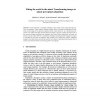Free Online Productivity Tools
i2Speak
i2Symbol
i2OCR
iTex2Img
iWeb2Print
iWeb2Shot
i2Type
iPdf2Split
iPdf2Merge
i2Bopomofo
i2Arabic
i2Style
i2Image
i2PDF
iLatex2Rtf
Sci2ools
ISVC
2007
Springer
2007
Springer
Fitting the World to the Mind: Transforming Images to Mimic Perceptual Adaptation
Abstract. Visual sensitivity is constantly adjusting to the current visual context through processes of adaptation. These adaptive changes strongly affect all perceptual judgments and optimize visual coding for the specific properties of the scenes before us. As a result human observers “see” better when they are first allowed to adapt to a specific context. The basic form of the response changes resulting from adaptation have been studied extensively and many are known in broad outline. Here we consider the advantages of applying these changes to images, to simulate the processes of adaptation that normally occur within the observer. Matching images to the observer may obviate the need for some forms of perceptual learning and offers a number of potential benefits for interacting with visual displays.
| Added | 08 Jun 2010 |
| Updated | 08 Jun 2010 |
| Type | Conference |
| Year | 2007 |
| Where | ISVC |
| Authors | Michael A. Webster, Kyle McDermott, George Bebis |
Comments (0)

